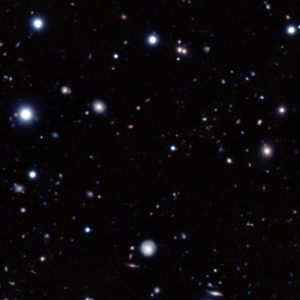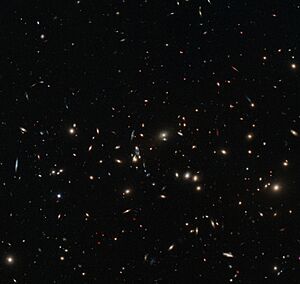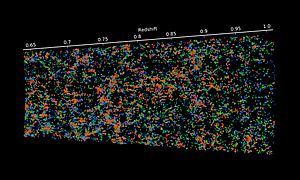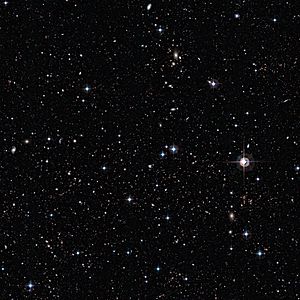Galaxy groups and clusters facts for kids
Galaxy groups and clusters are the biggest things in the Universe that are held together by gravity. They are the densest parts of the Universe's large-scale structure. Imagine the Universe as a giant web; galaxy groups and clusters are like the knots where many threads meet. Scientists believe that smaller groups of galaxies formed first. Over time, these smaller groups came together to create the much larger galaxy clusters. This process has been happening for about 10 billion years. A group or cluster can have anywhere from ten to thousands of individual galaxies. These clusters are often part of even bigger structures called superclusters, which are not held together by gravity.
Contents
What are Galaxy Groups?
Galaxy groups are the smallest collections of galaxies. They usually have fewer than 50 galaxies. These galaxies are spread out over a distance of about 1 to 2 megaparsecs (Mpc). To give you an idea, 1 megaparsec is about 3.26 million light-years! The total mass of a galaxy group is roughly 1013 solar masses, which means it's like 10 trillion times the mass of our Sun. The galaxies inside a group move around at speeds of about 150 kilometers per second.
It's important to know that these numbers are just a general guide. Sometimes, bigger galaxy systems are still called groups. Galaxy groups are very common in the Universe. At least half of all galaxies are found in groups. They are bigger than single very large elliptical galaxies but smaller than galaxy clusters.
Our own galaxy, the Milky Way, is part of a group called the Local Group. This group has more than 54 galaxies! In 2017, some scientists suggested that galaxy groups are collections of galaxies with a total mass less than 8 × 1013 solar masses.
What are Galaxy Clusters?
Galaxy clusters are much larger than groups. There isn't a super clear line between a very large group and a small cluster. When we look at clusters through telescopes, they seem like huge collections of galaxies held together by gravity. However, the galaxies inside a cluster move so fast that gravity from just the visible galaxies isn't enough to keep them together. This tells us that there must be something else adding to the mass, or another force at play.
Scientists have found something called the intracluster medium in clusters. This is a lot of very hot gas between the galaxies. This gas is super hot, between 10 million and 100 million degrees Celsius! Because it's so hot, it glows brightly in X-rays.

The total mass of this hot gas is actually about twice the mass of all the galaxies in the cluster! But even with the galaxies and the hot gas, there still isn't enough mass to explain why the cluster stays together. Scientists can figure out the total mass of a cluster by studying how this hot gas behaves. It turns out that the total mass is about six times more than the mass of the galaxies and the hot gas combined.
This missing mass is called dark matter. We don't know exactly what dark matter is, but it seems to make up most of the mass in a cluster. In a typical cluster, only about 5% of the total mass is in galaxies, and about 10% is in the hot X-ray gas. The rest, about 85%, is dark matter. Some scientists have different ideas, like modified gravity, to explain clusters without dark matter. However, observations of the Bullet Cluster are considered strong evidence for dark matter.
How Do Scientists Study Galaxy Clusters?

Scientists use many different ways to find and study galaxy clusters:
- Visible Light and Infrared: We can study individual galaxies in clusters using regular optical telescopes or infrared telescopes. Scientists find clusters by looking for areas where many galaxies are packed together. Then, they check if these galaxies are all at a similar redshift (which tells us their distance). Infrared telescopes are especially good for finding clusters that are very far away.
- X-ray: The super hot gas in clusters gives off X-rays. X-ray telescopes can detect these. Clusters are some of the brightest objects in the X-ray sky, along with AGN (active centers of galaxies).
- Radio: Some clusters have huge, spread-out structures that glow at radio frequencies. These are called radio halos. Scientists also use groups of radio sources to find clusters. For very distant clusters that are still forming, they look for groups of active galaxies that glow in radio waves.
- Sunyaev-Zel'dovich Effect: The hot electrons in the gas inside a cluster can interact with the cosmic microwave background (CMB), which is leftover radiation from the Big Bang. This interaction creates a "shadow" in the CMB at certain radio frequencies. Scientists can detect this shadow to find clusters.
- Gravitational Lensing: Galaxy clusters have so much mass that they can bend the light from galaxies located behind them. This bending effect, called gravitational lensing, makes the background galaxies look stretched or distorted. By studying these distortions, scientists can figure out how much dark matter is in the cluster and where it's located.
Why are Temperature and Density Important?

Galaxy clusters are the newest and most massive objects to form in the Universe's structure. Studying them helps us understand how galaxies form and change over time. Clusters have two key features: they are massive enough to hold onto any hot gas that comes from their member galaxies, and the heat energy of this gas can be seen in X-rays.
The condition of the gas inside a cluster tells us about its history. This gas gets heated up when new matter falls into the cluster. It also cools down by giving off radiation. Scientists study the gas's density, temperature, and how it's structured to learn about the entire heating and cooling history of the cluster's formation.
Famous Galaxy Groups and Clusters
| Name / Designation | What's special about it? |
|---|---|
| Local Group | This is the galaxy group where our own galaxy, the Milky Way, and our planet Earth are located! |
| Virgo Cluster | This is the closest large cluster of galaxies to us. |
See also
 In Spanish: Agrupación galáctica para niños
In Spanish: Agrupación galáctica para niños
- Entropy
- Fossil galaxy group
- Galactic orientation
- Galaxy filament
- Illustris project
- Intracluster medium
- Large-scale structure of the Cosmos
- List of galaxy groups and clusters
- Supercluster
- Timeline of knowledge about galaxies, clusters of galaxies, and large-scale structure




